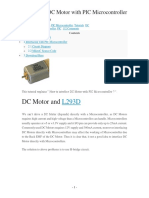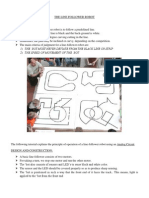0 ratings0% found this document useful (0 votes)
11 viewsNew Microsoft Word Document/MNN
New Microsoft Word Document/MNN
Uploaded by
Ashit SamdurThis document outlines the process for controlling a DC motor and stepper motor based on light dependent resistor (LDR) sensor readings. If LDR1 detects more light than LDR2, relay the DC motor to direction A. If LDR1 detects less light than LDR2, relay the DC motor to direction B. If LDR3 detects more light than LDR4, relay the stepper motor forward. If LDR3 detects less light than LDR4, relay the stepper motor in reverse.
Copyright:
© All Rights Reserved
Available Formats
Download as DOCX, PDF, TXT or read online from Scribd
New Microsoft Word Document/MNN
New Microsoft Word Document/MNN
Uploaded by
Ashit Samdur0 ratings0% found this document useful (0 votes)
11 views1 pageThis document outlines the process for controlling a DC motor and stepper motor based on light dependent resistor (LDR) sensor readings. If LDR1 detects more light than LDR2, relay the DC motor to direction A. If LDR1 detects less light than LDR2, relay the DC motor to direction B. If LDR3 detects more light than LDR4, relay the stepper motor forward. If LDR3 detects less light than LDR4, relay the stepper motor in reverse.
Original Description:
BBJKK
Original Title
New Microsoft Word Document\MNN
Copyright
© © All Rights Reserved
Available Formats
DOCX, PDF, TXT or read online from Scribd
Share this document
Did you find this document useful?
Is this content inappropriate?
This document outlines the process for controlling a DC motor and stepper motor based on light dependent resistor (LDR) sensor readings. If LDR1 detects more light than LDR2, relay the DC motor to direction A. If LDR1 detects less light than LDR2, relay the DC motor to direction B. If LDR3 detects more light than LDR4, relay the stepper motor forward. If LDR3 detects less light than LDR4, relay the stepper motor in reverse.
Copyright:
© All Rights Reserved
Available Formats
Download as DOCX, PDF, TXT or read online from Scribd
Download as docx, pdf, or txt
0 ratings0% found this document useful (0 votes)
11 views1 pageNew Microsoft Word Document/MNN
New Microsoft Word Document/MNN
Uploaded by
Ashit SamdurThis document outlines the process for controlling a DC motor and stepper motor based on light dependent resistor (LDR) sensor readings. If LDR1 detects more light than LDR2, relay the DC motor to direction A. If LDR1 detects less light than LDR2, relay the DC motor to direction B. If LDR3 detects more light than LDR4, relay the stepper motor forward. If LDR3 detects less light than LDR4, relay the stepper motor in reverse.
Copyright:
© All Rights Reserved
Available Formats
Download as DOCX, PDF, TXT or read online from Scribd
Download as docx, pdf, or txt
You are on page 1of 1
Start the process
If LDR1 > LDR 2
Direction A
If If LDR1 < LDR 2 Relay DC Motor
Direction B
If LDR3 > LDR 4
Forward
Relay Stepper
If LDR3 < LDR 4
Motor
Reverse
You might also like
- Transmission Fault CodesDocument9 pagesTransmission Fault CodesFranciscoOliveira86% (7)
- JLG E450AJ Manual de PartesDocument589 pagesJLG E450AJ Manual de PartesPaco100% (1)
- Automatic Control Systems and Components48298Document453 pagesAutomatic Control Systems and Components48298science1990100% (1)
- C2002 Speed Control Unit PDFDocument5 pagesC2002 Speed Control Unit PDFParesh Patel100% (3)
- Linetroll 110T R: User ManualDocument16 pagesLinetroll 110T R: User Manualluhusapa-1No ratings yet
- Unit-3 Speed Contol of DC and AC DrivesDocument70 pagesUnit-3 Speed Contol of DC and AC DrivesSurya SJNo ratings yet
- DETC Tower CarDocument12 pagesDETC Tower CarSSEOHEPSI MRKNo ratings yet
- Softstart Digistart D3 Slip Ring Motor Control Application NoteDocument3 pagesSoftstart Digistart D3 Slip Ring Motor Control Application NoteIsaac AwudiNo ratings yet
- EDC Unit-4Document36 pagesEDC Unit-4sivaNo ratings yet
- Unit-3 Speed Contol of DC and AC DrivesDocument70 pagesUnit-3 Speed Contol of DC and AC DrivesSurya SJNo ratings yet
- Edc Chapter 4Document36 pagesEdc Chapter 4ThendralNo ratings yet
- Engineering Application Guide: Fluor Daniel - Electrical/Control SystemsDocument2 pagesEngineering Application Guide: Fluor Daniel - Electrical/Control SystemsRenato AbalosNo ratings yet
- ZSS & LTDocument12 pagesZSS & LTkalimsail84No ratings yet
- DDI0484C Cortex m0p r0p1 TRM Parte27Document1 pageDDI0484C Cortex m0p r0p1 TRM Parte27Paolo RossiNo ratings yet
- Chapter 3 (1.0) (19-30)Document13 pagesChapter 3 (1.0) (19-30)Kaung KhantNo ratings yet
- Light Follower Robot: A.Nageswar RaoDocument25 pagesLight Follower Robot: A.Nageswar RaoMohsin ShaikhNo ratings yet
- 12V Car Battery Charger: Part ListDocument3 pages12V Car Battery Charger: Part ListronnelnacpilNo ratings yet
- Water Level IndicatorDocument9 pagesWater Level Indicatorপ্রদীপ্ত দত্তNo ratings yet
- Project of MAA 1Document21 pagesProject of MAA 1Pranil KambleNo ratings yet
- Automatic Plant Irrigator Using MicroController2Document5 pagesAutomatic Plant Irrigator Using MicroController2Sumith KumarNo ratings yet
- By Ligo George MikroC, PIC Microcontroller InterfcingDocument5 pagesBy Ligo George MikroC, PIC Microcontroller InterfcingLawrence NgariNo ratings yet
- Es 321 Power Electronics: - Power Semiconductor Diodes and Circuits 06 Lecture Diode CharacteristicsDocument23 pagesEs 321 Power Electronics: - Power Semiconductor Diodes and Circuits 06 Lecture Diode Characteristicsunity123d deewNo ratings yet
- 11 Webinar Directional Overcurrent RelayingDocument47 pages11 Webinar Directional Overcurrent Relayingfrodo frodo100% (1)
- Power Electronics Power Electronics: Course: BookDocument15 pagesPower Electronics Power Electronics: Course: BooksufiiiiyanNo ratings yet
- Installing Powerboss On Two Speed MotorsDocument3 pagesInstalling Powerboss On Two Speed MotorsAdina DumitrescuNo ratings yet
- Course Name: Hybrid Electric Vehicle Theory and Design Course Code: HEVTDDocument20 pagesCourse Name: Hybrid Electric Vehicle Theory and Design Course Code: HEVTDAmit Kumar BaghelNo ratings yet
- Line FollowerDocument13 pagesLine FollowerFarah AzamNo ratings yet
- 12V Car Battery ChargerDocument2 pages12V Car Battery ChargerbocahgmhNo ratings yet
- RTWP TroubleshootingDocument5 pagesRTWP TroubleshootingOgg SilverlemoneNo ratings yet
- LR9 7Dppppp: Current Transformer OperatedDocument2 pagesLR9 7Dppppp: Current Transformer OperatedandreNo ratings yet
- Switch Mode Power Supply (SMPS) : Prepared by Dhrumil H. ShethDocument31 pagesSwitch Mode Power Supply (SMPS) : Prepared by Dhrumil H. ShethBharatNo ratings yet
- Kit Availability Requirement Remarks: SL - No Name of The ExperimentDocument2 pagesKit Availability Requirement Remarks: SL - No Name of The ExperimentBindajNo ratings yet
- Pair Task Activity #03-00-08 Automatic LightDocument2 pagesPair Task Activity #03-00-08 Automatic LightRissy Kh XhieNo ratings yet
- CE Cong Issue Troubleshooting Step and Guidence - Good RefDocument6 pagesCE Cong Issue Troubleshooting Step and Guidence - Good RefKurnia Chris Pradana WicaksonoNo ratings yet
- DDR3 Device Operation Timing DiagramDocument154 pagesDDR3 Device Operation Timing DiagramPavani AchyuthaNo ratings yet
- 7 STC TRS Con 02 I Relays & SwitchesDocument47 pages7 STC TRS Con 02 I Relays & Switchesmikkumar5No ratings yet
- Switched-Mode DC Power Supplies: Presentation byDocument31 pagesSwitched-Mode DC Power Supplies: Presentation byanon_319514091No ratings yet
- Ddi0439b Errata 01Document5 pagesDdi0439b Errata 01Ahmed TriguiNo ratings yet
- Ehc 500MWDocument26 pagesEhc 500MWRaja Vignesh100% (1)
- EcNo Criteria For CS IRATDocument13 pagesEcNo Criteria For CS IRATQasim Abbas AlviNo ratings yet
- 3ph TSD 2024Document212 pages3ph TSD 2024chellappamglNo ratings yet
- DDR3 Timing DiagramDocument150 pagesDDR3 Timing DiagramDeepak KurupNo ratings yet
- Microcontroller Control Systems Systems Operation: Tr6 Base Input Signal, Tr5 OnDocument11 pagesMicrocontroller Control Systems Systems Operation: Tr6 Base Input Signal, Tr5 OnMHT FixNo ratings yet
- Stage 3 (Start UP and TAB)Document7 pagesStage 3 (Start UP and TAB)kyaw htin mawNo ratings yet
- Wireless TechometerDocument2 pagesWireless TechometerAbhishek SauravNo ratings yet
- Basic Micromouse CircuitDocument2 pagesBasic Micromouse CircuitAkshat KaleNo ratings yet
- PLC Programming Ladder LogicDocument18 pagesPLC Programming Ladder LogicPackiyaraj BMSNo ratings yet
- Chapter3 RelayDocument27 pagesChapter3 RelayHarmanPakWanNo ratings yet
- Hanbay Electric Actuators Page 5 - 6Document2 pagesHanbay Electric Actuators Page 5 - 6Farobi RifqiNo ratings yet
- DQ542MADocument5 pagesDQ542MADima RedkinNo ratings yet
- Power ElectronicDocument30 pagesPower ElectronicHidayahNo ratings yet
- Tangential and Normal ComponentsDocument15 pagesTangential and Normal ComponentsOmar DoskyNo ratings yet
- Huawei 2G HandoverDocument32 pagesHuawei 2G HandoverRizal Mambaul AsnawiNo ratings yet
- Ug 5th LCPWMDocument2 pagesUg 5th LCPWMBabbu DograNo ratings yet
- Chapter6 Speed Control DCDocument36 pagesChapter6 Speed Control DCAzmi Shah Alias KhooNo ratings yet
- Optimize Accessibility 3G NSNDocument3 pagesOptimize Accessibility 3G NSNsamtec32No ratings yet
- AdhesionDocument10 pagesAdhesionAlexander MugabeNo ratings yet
- Automatic Street LightDocument17 pagesAutomatic Street LightRaksha SharmaNo ratings yet
- RPR415 Manual - InddDocument4 pagesRPR415 Manual - InddhashimNo ratings yet
- Reverse Power Relay RPR415 User's Guide: FeaturesDocument4 pagesReverse Power Relay RPR415 User's Guide: Featuresmohamadfirdaus84No ratings yet
- Instructions PLC MitsubishiDocument41 pagesInstructions PLC MitsubishiTrần Đức TháiNo ratings yet
- DiagramDocument1 pageDiagramAshit SamdurNo ratings yet
- DiagramDocument1 pageDiagramAshit SamdurNo ratings yet
- DiagramDocument1 pageDiagramAshit SamdurNo ratings yet
- DiagramDocument1 pageDiagramAshit SamdurNo ratings yet
- Adsd Lab Manual LhsDocument45 pagesAdsd Lab Manual LhsAshit SamdurNo ratings yet
- Ghaziabad Unit: Application For Post of Contract EngineersDocument2 pagesGhaziabad Unit: Application For Post of Contract EngineersAshit SamdurNo ratings yet
- Fused Arcing Horns: and Grading RingsDocument3 pagesFused Arcing Horns: and Grading RingsPriska Dwi AnggitaNo ratings yet
- Novel Zero-Current-Transition PWM Converters: Eric X. CDocument6 pagesNovel Zero-Current-Transition PWM Converters: Eric X. Ccarlos_eqnNo ratings yet
- HD4 - Catalog - EN - 1YHA000046 - REV A - 08-2022Document42 pagesHD4 - Catalog - EN - 1YHA000046 - REV A - 08-2022hungNo ratings yet
- Transformer Lecture 1Document42 pagesTransformer Lecture 1Kabiru FaisalNo ratings yet
- Battery Protector Cut Out Switch With ATtiny85 ForDocument13 pagesBattery Protector Cut Out Switch With ATtiny85 Forapo katsaroNo ratings yet
- Passive and Active Battery Balancing Comparison Based On MATLAB SimulationDocument7 pagesPassive and Active Battery Balancing Comparison Based On MATLAB SimulationNhật NguyễnNo ratings yet
- SKT1000 04D SemikronDocument6 pagesSKT1000 04D Semikronaldacirjoe8360No ratings yet
- Transient Protection For PV Power ElectronicsDocument14 pagesTransient Protection For PV Power ElectronicsBuba Sani DahiruNo ratings yet
- Safety Sensor 171Document17 pagesSafety Sensor 171valorantnoob1100% (1)
- Detuned, Series Filter Reactor: For Power Factor Correction CapacitorDocument4 pagesDetuned, Series Filter Reactor: For Power Factor Correction Capacitorctxd758n100% (1)
- List of Standards Collection-TransformersDocument7 pagesList of Standards Collection-TransformerssbpathiNo ratings yet
- Datasheet - 6832-1Document4 pagesDatasheet - 6832-1Jun AntonioNo ratings yet
- AIM: To Plot The Static V-I Characteristic of SCR, MOSFET and IGBT ApparatusDocument4 pagesAIM: To Plot The Static V-I Characteristic of SCR, MOSFET and IGBT ApparatuskashishlalaNo ratings yet
- FT DVPOWER TRT500 Rev1 PDFDocument14 pagesFT DVPOWER TRT500 Rev1 PDFUlyyszesz AalvaaraadooNo ratings yet
- Relative and Differential Pressure Switch Type 604Document5 pagesRelative and Differential Pressure Switch Type 604sukamtoNo ratings yet
- Distribution System Grounding FundamentalsDocument17 pagesDistribution System Grounding FundamentalsJose Alberto RodriguezNo ratings yet
- New Microsoft PowerPoint PresentationDocument13 pagesNew Microsoft PowerPoint PresentationSri ChandanaNo ratings yet
- 74HC4543Document12 pages74HC4543Anung PriyantoNo ratings yet
- Digital Output Module SM 322 DO 8 X DC 48-125 V/1.5 A (6ES7322-1CF00-0AA0)Document4 pagesDigital Output Module SM 322 DO 8 X DC 48-125 V/1.5 A (6ES7322-1CF00-0AA0)Fabio CavalheiroNo ratings yet
- RF CMOS Background: July 2011Document17 pagesRF CMOS Background: July 2011Srijeet TripathyNo ratings yet
- Automatic Ignition Control: Application SpecificationsDocument10 pagesAutomatic Ignition Control: Application SpecificationsFet hiNo ratings yet
- Nissan EV TechnologiesDocument72 pagesNissan EV TechnologiesDSNY DSNYNo ratings yet
- Thermocouple: Tolerances On Temperature ReadingDocument34 pagesThermocouple: Tolerances On Temperature ReadingMilind Kshirsagar100% (1)
- CT2N Wiper Control System User ManualDocument13 pagesCT2N Wiper Control System User ManualjowdiverNo ratings yet
- EFW 1C DocumentationDocument6 pagesEFW 1C DocumentationdouglasfcxNo ratings yet
- 9a6o4-A5-01ar1a SiemonDocument2 pages9a6o4-A5-01ar1a SiemonKmila ClavijoNo ratings yet
- Substation Testing and Commissioning Power Transformer Throught Fault TestDocument6 pagesSubstation Testing and Commissioning Power Transformer Throught Fault TestSabyasachi KarNo ratings yet





























































































